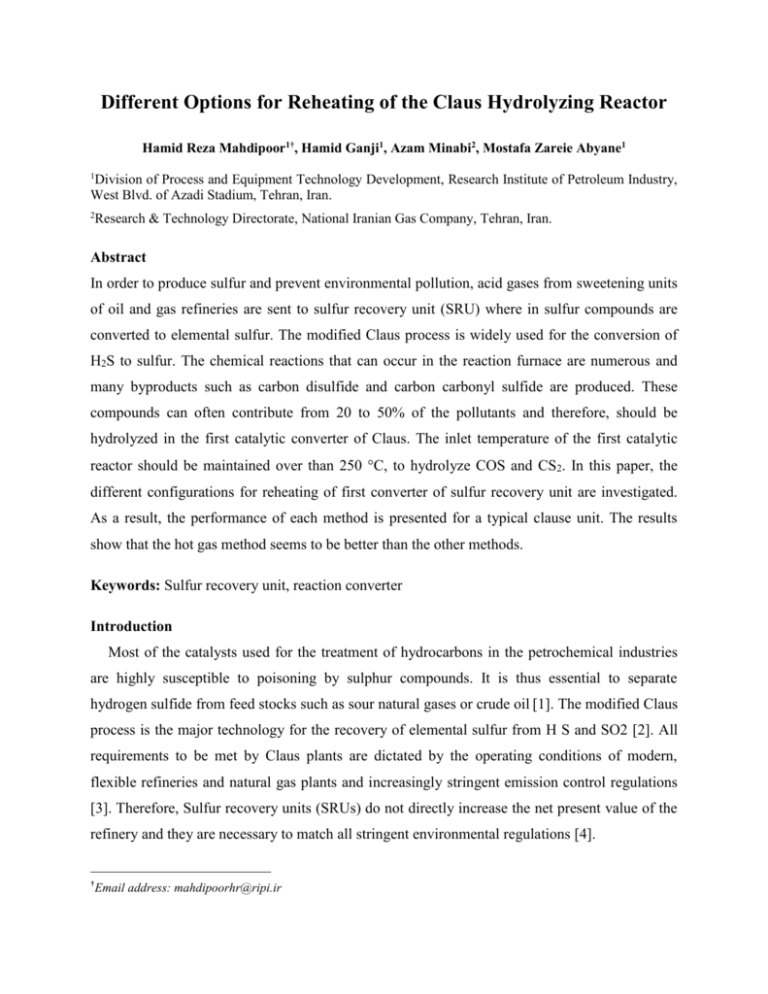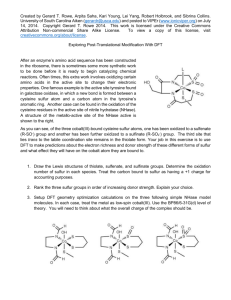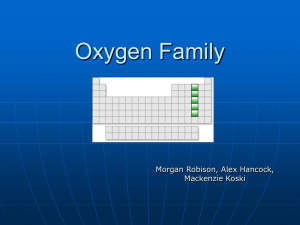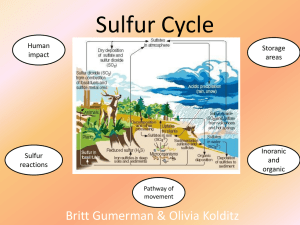Different-Options-for-Reheating-of-the-Claus-Hydrolyzing
advertisement

Different Options for Reheating of the Claus Hydrolyzing Reactor Hamid Reza Mahdipoor1†, Hamid Ganji1, Azam Minabi2, Mostafa Zareie Abyane1 1 Division of Process and Equipment Technology Development, Research Institute of Petroleum Industry, West Blvd. of Azadi Stadium, Tehran, Iran. 2 Research & Technology Directorate, National Iranian Gas Company, Tehran, Iran. Abstract In order to produce sulfur and prevent environmental pollution, acid gases from sweetening units of oil and gas refineries are sent to sulfur recovery unit (SRU) where in sulfur compounds are converted to elemental sulfur. The modified Claus process is widely used for the conversion of H2S to sulfur. The chemical reactions that can occur in the reaction furnace are numerous and many byproducts such as carbon disulfide and carbon carbonyl sulfide are produced. These compounds can often contribute from 20 to 50% of the pollutants and therefore, should be hydrolyzed in the first catalytic converter of Claus. The inlet temperature of the first catalytic reactor should be maintained over than 250 C, to hydrolyze COS and CS2. In this paper, the different configurations for reheating of first converter of sulfur recovery unit are investigated. As a result, the performance of each method is presented for a typical clause unit. The results show that the hot gas method seems to be better than the other methods. Keywords: Sulfur recovery unit, reaction converter Introduction Most of the catalysts used for the treatment of hydrocarbons in the petrochemical industries are highly susceptible to poisoning by sulphur compounds. It is thus essential to separate hydrogen sulfide from feed stocks such as sour natural gases or crude oil [1]. The modified Claus process is the major technology for the recovery of elemental sulfur from H S and SO2 [2]. All requirements to be met by Claus plants are dictated by the operating conditions of modern, flexible refineries and natural gas plants and increasingly stringent emission control regulations [3]. Therefore, Sulfur recovery units (SRUs) do not directly increase the net present value of the refinery and they are necessary to match all stringent environmental regulations [4]. † Email address: mahdipoorhr@ripi.ir The modified Claus process consists of a high temperature front-end reaction furnace, followed by catalytic reaction stages. This process continues to be the most widely used process for the conversion of H2S to sulfur. Generally, Byproduct gases originating from physical and chemical gas and oil treatment units in refineries, natural gas processing and gasification plants are also routed to Claus unit [3]. The overall reaction characterizing the process is as follows [4], 2H2S O2 S2 2H2O (1) A key reaction that occurs in front-end reaction furnace is a two step sequence, 1/3 of the acid gas is oxidized to SO2 using air, H 2S 3 O 2 SO 2 H 2 O 2 (2) This combustion generates a large amount of heat. Further, the combustion products undergo Claus reaction between H2S and SO2, 2H2S SO2 3 2 S2 2H2O (3) Reaction 3 is a reversible exothermic reaction. Thus, processing under adiabatic condition greatly increases temperature, which lowers equilibrium conversion to about 75%. Effluent gas from the reaction furnace passes through a waste heat boiler (WHB) to recover heat and produce high-pressure steam. Likewise, a large amount of elemental sulphur (S2) are produced during of thermal decomposition H2S. In fact, Elemental sulfur produced in the furnace is about 50-60% of the total sulfur production of the plant [5]. In the second step or catalytic reaction stages, the remained unreacted H2S are reacted with SO2, over an alumina catalyst to form elemental sulfur in fixed bed reactors. The reaction is the same as eq. 3 [1,6]. Since this reaction is exothermic, decreasing the temperature leads the equilibrium reaction toward right hand, i.e. more sulfur yields. On the other hand, low temperatures decrease the reaction rate. Therefore, an appropriate catalyst must be used to increase the reaction rate. However, high sulfur yields still necessitate a multistage process with interstage cooling and sulfur condensation [7]. Although the modified Claus process has remained relatively unaltered since its introduction, further modifications to the basic process have been introduced in order to increase the plant capacity or efficiency [8]. As mentioned before, the chemical reactions that can occur in the reaction furnace are numerous and many byproducts such as carbon disulfide (CS2) and carbon carbonyl sulfide (COS) are produced. These compounds can often contribute from 20 to 50% of the pollutants in the tail-gas [9-12]. Furthermore, presence of O2 traces in the CS2 - H2O mixture caused a decrease in the activity of alumina and titania catalysts due to sulfate formation [13]. Therefore, COS and CS2 should be hydrolyzed in the catalytic converter [14,15], as shown below: COS H2O H2S CO2 (4) CS2 2H2O 2H2S CO2 (5) The temperature of the first catalytic reactor is maintained at about 350 C to hydrolyze COS and CS2, while that of the subsequent reactors is just above the sulfur vapor dew point [21]. Transition metal oxides can be used to modify gamma-alumina to form a catalyst that is effective at temperatures higher than the dew point of sulfur [16-18]. As mentioned before, effluent gas from the reaction furnace passes through a WHB which makes it cold to condense produced sulfur. Several ways are available for reheating the process gas entering to first converter, including the hot gas bypass method, the direct fired method, and the indirect reheat methods [19]. The hot gas bypass method takes a slip-stream of hot process gases from the waste heat recovery unit, usually at 480 - 650 °C, and mixes this stream with the sulfur condenser outlet gases upstream of the catalytic converter. Hot gas bypass reheating is normally the lowest cost alternative, is relatively simple to control, and results in low pressure drop. Its disadvantage is lower overall sulfur recovery, particularly at reduced throughput [19]. The direct fired method of reheating uses inline burners to burn either fuel gas or acid gas, and mix the combustion products with the WHB outlet gases. Potential disadvantages of inline burners are the possible formation of SO3, if acid gas is burned (sulfates deactivate the catalyst) and of soot, if fuel gas is burned. Soot can plug and also deactivate the catalyst. Moreover, Oxygen in as low a concentration as 30 ppmv can rapidly sulfate the catalyst [19]. The indirect reheat methods use direct fired heaters or heat exchangers to heat the sulfur condenser outlet gases; high pressure steam, hot oil, and hot process gases have been used. Electrical reheating has also been used. Indirect reheating, which involves a heat exchanger ahead of each catalytic converter, is the most expensive alternative and results in the highest pressure drop. In addition, converter inlet temperatures are limited by the temperature of the heating medium. For example, the use of 4140 KPa steam at 254°C as the heat source would limit the converter inlet temperature to a maximum of about 243°C. Thus, catalyst rejuvenation is usually not possible and COS and CS2 hydrolysis may be more difficult [19]. In the next section, different methods for reheating of Claus hydrolyzing reactor are investigated. The results are achieved by simulation of an Industrial Claus unit. Investigating different method of Reheating A typical unit of Clause sulfur recovery is considered. The schematic shape of such a modified two-stage SRU plant is shown in figure 1. In order to investigate different options for the first converter reheating, a typical unit of Claus sulfur recovery is considered. The conditions of acid gas feed stream is presented in table 1. Figure1. A schematic shape of a modified two-stage Claus process with acid gas and air preheating and hot gas configurations Table1. The conditions of acid gas feed stream Property Value Temperature 60 ⁰C Pressure 1.8 bara Molar Flow 750 Kmole/h Composition (molar) H2S 33 CO2 57 H2O 10 At the first step, we study indirect method for reheating the inlet stream of first converter. Since we use often HPS (High Pressure Steam) as heating medium, heating more than 250 ⁰C is difficult. In this study, super heated steam at 260 ⁰C and 41.5 bar is used. Figure 2 represents the changes of HPS mass flow rate vs. the temperature of first converter inlet stream. As is shown in this figure, it seems that temperature of first converter inlet stream will increase linearly with increasing the steam mass flow rate. But since the temperature of super heated steam is 260 ⁰C, reheating more than 250 ⁰C lead to approach temperature and internal pinch point problems in heat exchanger design and design in this condition is not possible. As mentioned before, increasing this temperature will improve COS and CS2 Hydrolyze in the first converter and using direct method may not be a good alternative in serious cases with high COS and CS 2 contents. Furthermore, using HPS will increase working capital and maintenance costs and enhance overall pressure drop of SRU which is a critical parameter in operatibility of unit. Figure2. The changes of HPS mass flow vs. the temperature of first converter inlet stream At second step, using hot gas will be studied. As mentioned at introduction, among available alternatives, the best configuration for reheating of firs reactor inlet stream seems to be using hot gas (see figure 1, after WHB). Figure 3 represents the changes in the temperature of first converter inlet stream with changes in the hot gas split ratio. As is shown in this figure, the temperature of 250 ⁰C which is an appropriate temperature for first converter inlet stream is achievable at hot gas split ratio equal to about 6.5 percent. Although using hot gas omits the cost of using high pressure steam, it can decrease overall sulfur recovery of unit. However, it can be compensated when tail gas treatment unit is applied after Claus sulfur recovery unit. More increase in the temperature of first converter inlet stream is possible by increasing the hot gas bypass ratio. Finally, the use of inline burners will be investigated for reheating the process gas flowing to first converter. The inline burner burns a portion of acid gas feed to SRU or the fuel gas to produce a hot gas. Mixing this hot gas with outlet stream of WHB will increase the temperature of first converter inlet stream. This method omit the pressure drop of the heat exchanger in the first method and operability problems of second one, but decrease of overall sulfur recovery is present yet, because it insert the large amounts of inert gas to the process gas. Moreover, the cost of fuel gas will increase working capital investment. For this case study, using a fuel gas inline burner is supposed. Figure 4 show the increase in the temperature of first converter inlet stream with the increase of fuel gas (hear we use natural gas) flow rate. As is shown in figure, 55 Kg/h is required to reach the temperature of first converter inlet stream above 250 ⁰C. Figure3. The changes in temperature of first converter inlet stream vs. hot gas split ratio Figure4. The changes in temperature of first converter inlet stream vs. mass flow rate of fuel gas inserting into the inline burner Conclusions The modified Claus process is widely used for the conversion of H2S to sulfur. Many byproducts such as carbon disulfide and carbon carbonyl sulfide are produced in the Claus reaction furnace. These compounds should be hydrolyzed in the hydrolyzing reactor to reduce pollutants. The inlet temperature of the first catalytic converter should be maintained over than 250 C, to hydrolyze COS and CS2. In this paper, the various configurations for reheating of hydrolyzing reactor in an industrial sulfur recovery unit were investigated. The achieved results show that the performance of each method and it was shown that using hot gas seems to be better than the other methods, especially when COS and CS2 are major problem in SRU. References [1] Elsner, M. P., Menge, M., Müller, C., Agar, D. W., The Claus process: teaching an old dog new tricks, Catalysis Today 79–80 (2003) 487-494. [2] Eow, J. S., Recovery of Sulfur from Sour Acid Gas: A Review of the Technology, H. Fisher, Burner/Fire box design improves sulfur recovery, Hydrocarbon processing (1974 OCT.) 27-30. [3] ZareNezhad, B., An investigation on the most important influencing parameters regarding the selection of the proper catalysts for Claus SRU converters, J. Ind. Eng. Chem. 15 (2009) 143147. [4] Signor, S., Manenti, F., Grottoli, M. G., Fabbri, P., and Pierucci, S., Sulfur Recovery Units: Adaptive Simulation and Model Validation on an Industrial Plant, Ind. Eng. Chem. Res. 2010, 49, 5714-5724. [5] Nasato, L. V., Karan, K., Mehrotra, A. K., and Behie, L. A., Modeling Reaction Quench Times in the Waste Heat Boiler of a Claus Plant, Ind. Eng. Chem. Res. 1994, 33, 7-13. [6] Dowling, N. I., Hyne, J. B., and Brown, D. M., Kinetics of the Reaction between Hydrogen and Sulfur under High-Temperature Claus Furnace Conditions, Ind. Eng. Chem. Res. 1990, 29, 2327-2332. [7] Mahdipoor, H. R., Khorsand, K., Hayati, R., Javaherizadeh, H., Effect of Reaction Furnace and Converter Temperatures on Performance of Sulfur Recovery Units (SRUs), Journal of Petroleum Science Research, accepted to published, 2012. [8] McIntyre, G., Lyddon, L., Claus Sulphur Recovery Options, Bryan Research and Engineering, Inc. Technical Papers, Bryan, Texas. [9] Huisman H.M., P. van der Berg, R. Mos, A.J. van Dillen, and J.W. Geus, Hydrolysis of Carbon Sulfides on Titania and Alumina Catalysts: The Influence of Water, Applied Catalysis A, 115 (1994) 157-172. [10] Gens, T.A., Decrease in Carbonyl Sulfide in the Feed to Claus Converters by Shift Catalysts, Ind. Eng. Chem. Res. 33 (1994) 1654-1656. [11] Paskall, H.G.: ·Reaction Furnace Chemistry and Operational Modes· Proceedings of Gas SWeetening and Sulphur Recovery Seminar, Comprimo/Western Research, Amsterdam (November, 1982). [12] Sames, J.A., Dale, P.R., Wong, B.: ·Evaluation of Reaction Furnace Variables in ModifiedClaus Plants· Proceedings of Lawrence Reid Gas Conditioning Conference, Norman, Oklahoma, (March, 1987). [13] Laperdrix, E., I. Justin, G. Costentin, 0. Saur, J.C. Lavalley, A. Aboulayt, J.L. Ray, and C. Nedez, Comparative Study of CS2 Hydrolysis Catalyzed by Alumina and Titania, Applied Catalysis B: Environment, 17 (1998) 167-173. [14] Puchyr, D.M J., A.K Mehrotra, LA Behie, and N. Kalogerakis, Hydrodynamic and Kinetic Modeling of Circulating Fluidized Bed Reactors Applied to a Modified Claus Plant, Chem. Eng. Sci. 51 (1996) 5251-5262. [15] Maadah, A.G. and R.N. Maddox, Predict Claus Product, Hydrocarbon Processing 57 (1978) 143-146. [16] Burns, R.A., R.B Lippert, and R.K. Kerr, Choose Catalyst Objectively, Hydrocarbon Processing, 53 (1974) 181-186. [17] George, Z.M., Effect of Catalyst Basicity for COS, SO2 and COS Hydrolysis Reactions, J. catalysis, 35 (1974) 218-224. [18] Terorde, R.J.A.M., PJ. van den Brink, L.M. Visser, A.J. van Dillen, and G.W. Geuss, Selective Oxidation of Hydrogen Sulfide to Elemental Sulfur Using Iron Oxide Catalysts on Various Supports, Catalysis Today 17 (1993) 217-224. [19] Gas Processors Suppliers Association (GPSA). Engineering Data Book; GPSA Tulsa, 1987; Chapter 22.





